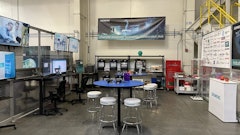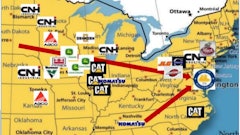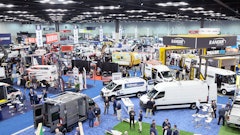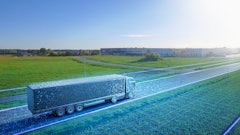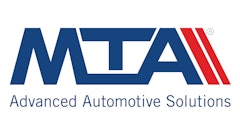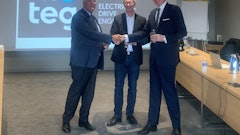Agritechnica 2015, the world’s leading forum for the future of the agricultural sector, is celebrating the 30th year since it started with record exhibitor participation. As Dr. Reinhard Grandke, Chief Executive Officer of the organizer DLG (Deutsche Landwirtschafts-Gesellschaft – German Agricultural Society), told the international press, up to and including Saturday, November 14, 2015, the Fairgrounds in Hanover will be the meeting place and forum for the world’s agricultural sector. “With more than 2,900 exhibitors from 52 countries we have reached a new record level,” said the DLG CEO. “The Fairgrounds are fully booked.” Agritechnica is thus impressively continuing its success story and further consolidating its leading position as the international trade fair for agricultural machinery and equipment and the agricultural sector.
Agritechnica celebrated its premiere in Frankfurt am Main in 1985, the year marking the centenary anniversary of the founding of DLG. There were 551 exhibitors, including 198 from outside Germany, and 125,000 visitors. Since then, Agritechnica has grown steadily as regards both exhibitor numbers and exhibition space. Development was driven by German reunification, the dynamic global political and economic changes, and the emergence of a “greater Europe.” The relocation from Frankfurt am Main to Hanover in the year 1995 led to a further clear boost in the growth of Agritechnica. Hanover was and still is considered as the gateway to the markets in the countries of Central and Eastern Europe. Furthermore, in recent years the global interconnectedness of the entire agricultural industry, as well as the growing economic significance of agriculture have increased substantially. Farming and agricultural machinery and equipment are the future. They play the key role in feeding the growing world population.
This impressive trend of Agritechnica is reflected on the visitor side too. Whereas around 125,00 specialists, including 15,000 international visitors, came to gather information at the first event in 1985, in 2013 some 450,000 specialists and experts made their way to Hanover, including over 100,000 international visitors.
DLG is expecting over 400,000 visitors again this year as well, including 100,000 from outside Germany.
Outstanding international participation
Participation by international exhibitors is outstanding this year (56%). Compared with 2013, these exhibitor numbers have risen again by around 7%. The largest contingents of the altogether 1,627 companies from outside Germany come from Italy (399 companies), the Netherlands (133), Turkey (112), France (103), China (100), Austria (71), Poland (70), Canada (61), the USA (52), Denmark (47), the United Kingdom (45), Spain (45), Finland (40), India (38) and Sweden (36). Strong increases by comparison with 2013 can be noted from Italy, the Netherlands, Turkey, India, Poland and Sweden. It is striking that higher numbers have been registered from virtually all countries. DLG understands this to be a clear indication that the international manufacturers are increasingly using Agritechnica to gain access to markets around the world. At the same time DLG sees this as confirmation for its strategy of specialist pre-trade fair events in numerous countries and further broadening of its travel service, as is also reflected for instance in 20 official country pavilions.
Agritechnica: Driver of innovation for agriculture
Agritechnica is the most important driver of innovation for agriculture. This is manifested by the over 300 innovations submitted to DLG by the exhibitors. These are characterized by a consistent stream of new developments in the electronics and sensor segments. Today these sectors largely define the degree of innovation of systems and machines with the goal of making processes even more efficient, precise, environmentally kind and cost-saving. The trend towards automating labor processes in crop production is flanked by the development of intelligent software in order to meet growing requirements made of documentation, quality assurance, traceability and logistics, fleet management and machine monitoring to minimize downtime and repair costs. The developments, in conjunction with an intelligent and simple data management system, lead to networked structures that map the entire process chain from field to fork. Solutions to these issues will be on show in abundance at Agritechnica. Agritechnica Specials, such as for example “Smart Farming – Digital Cropping”, will also be highlighting current developments and trends.
Systems & Components
The “Systems & Components” platform for suppliers under the umbrella of Agritechnica has taken off with the top theme “Future Farming.” This is where the visitors can acquire a complete overview of innovations, trends and developments in the fields of engines and motors, hydraulics, axles, driveline technology, cabs, electronics, replacement and wear parts, and user-friendly software. This year “Systems & Components” is concentrating principally on the four technology trends: efficiency, reliability, safety/ergonomics and environmental impact (CO2 footprint).
However, Agritechnica is not just an innovations platform for modern machinery and engineering, but also a source of ideas and impulses, as well as a trendsetter for major questions concerning the future of agribusiness and agricultural machinery and equipment. With its top-flight technical programme featuring a large number of international events, such as congresses, workshops and forums, Agritechnica is the most important forum for the future of the agricultural sector.
Modern agriculture needs consensus with society
The global challenges can only be mastered with an innovative agricultural sector that incorporates the continuous further developments in knowledge and skills. One of the basic requirements for this is robust and continuous consensus with society about agricultural production processes. Progress in agricultural production and production methods as well as their evaluation by society must fundamentally coincide. That is why the great challenge for agriculture consists in coming to terms with society’s acceptance of modern farming, developing accepted solutions and integrating these into the agricultural stakeholders’ own farm and business strategies. The innovations in agricultural machinery and equipment, which make substantial contributions to sustainable farming that protects the environment and conserves resources, represent a special opportunity for such dialogue with society.
Current situation on the markets
The global grain harvest has turned out to be abundant. The supply exceeds demand. The building up of stocks in the exporting countries has led to pressure on prices for cereals. At present, export demand for grain is picking up and prices are rising as a result. Alongside Russia and Ukraine, European grain producers are also enjoying export opportunities. This has led to a rise in grain prices and improvements in marketing conditions.
The situation on the milk market is uneven. Admittedly prices for skimmed milk powder and butter have risen recently in the EU. The world market price for milk also increased in the second half of October. The current Global Dairy Trade round has resulted in price reductions for dairy products. Positive price developments are likely to remain limited in view of the record milk deliveries in the EU. Difficult economic conditions will persist for dairy farmers.
Pig production in the European Union is characterized by an increase of 1.2% in the numbers slaughtered by comparison with 2014. In Germany the increase totaled 2.6%. Pig supplies remain high, so that sustained pressure on prices is to be expected. The strong grain and soy harvests account for low prices in a five-year comparison and will relieve the burden of feed costs for pig farmers.
Business situation and business development
Farmers in Germany, the United Kingdom and Poland are distinctly less satisfied with their current business situation than they were in the spring. This is revealed by the results of the Trendmonitor Europe, which DLG has just conducted together with Europe’s leading agricultural market research institute, the Kleffmann Group (Lüdinghausen, Westphalia), in Germany, France, the United Kingdom and Poland. The animal farmers in particular are less satisfied, while the cash crop producers assess the situation as stable. This reflects the current low level of producer prices, which are hitting pig and dairy farmers particularly hard. In France the mood is stable at a low level (score unchanged at 3.4). The government measures taken to ease the burden on the animal farmers appear to be calming the situation. As a result of the record harvest with good qualities, the French cash crop producers are more satisfied than the animal farmers.
The animal farmers in all four countries are less optimistic as regards expectations of business development. The dairy and pig farmers especially are sceptical. The market situation is unlikely to change, as milk and pig supplies remain substantial. Furthermore, French dairy farmers – who currently receive the highest prices compared with the rest of Europe – are now encountering growing competition from rising milk imports. The farmers are also involved in a conflict with meat processers about price determination and price setting for slaughter pigs.
The business expectations of cash crop producers in Germany, France and Poland are stable by comparison with the spring survey. The drought did not lead to the anticipated cuts in yield. The farmers expect rising prices for the winter due to the growing export demand for cereals. In addition, business is likely to liven up as demand from domestic processers grows, once they have used up their own stocks.
Readiness to invest varies
Compared with the spring 2015 survey, readiness to invest has declined in Germany to 42 percentage points, in Poland to 39 percentage points and in the United Kingdom to 24 percentage points. In France on the other hand, readiness to invest has increased slightly by 2% to now 23 percentage points. In Germany, Poland and the United Kingdom, the farmers have expanded their capacities over the past five years and renewed their plant and technology. In phases of low producer prices, the focus tends to be more on protecting liquidity, especially on farms that have invested in recent years and whose debt service costs have increased. Any new investments are postponed. In France, by comparison, the readiness to invest is stable, though at a low level. While the readiness of pig and dairy farmers to invest displays a downward trend, cash crop producers plan to invest more strongly (score up from 9 percentage points in spring 2015 to 22 percentage points in the current survey).
Investment segments – boost for arable farming
In the planned investments will be channelled more strongly into arable farming (+10 percentage points by comparison with the spring 2015 survey). Farmers in the United Kingdom are diversifying their production more strongly. Investments will be shared between boosting bioenergy (with +7 percentage points) and strengthening crop production (with +4 percentage points). Furthermore, 46 per cent of those farmers planning to invest want to expand existing capacities. By comparison, the farmers in Poland are seeking to invest in animal husbandry.
Farmers in The sectors into which investments are to flow have shifted strongly to arable farming by +26 percentage points, taking the score to now 74 percentage points.
Focus on challenges in arable farming
In the coming years, cash crop producers will have to adjust to a situation in which fewer active ingredients are available for crop protection, and in addition more conditions and requirements will have to be met (for instance greening). Against this background it is important for the farmers in Germany, France and Poland to use fertilizers more efficiently. Farmers in Germany, France and Poland plan to broaden their cultivation programme and grow more summer crops and more catch crops. The farmers in Germany are correspondingly interested in innovations in fertilizer machinery and equipment (64%). Farmers also expect innovations in stationary data processing (43%), the use of Cloud software solutions (26%), and in machinery and equipment for precision drilling (46%), all in order to improve production.
Customized concepts needed for digitization
The digitizing of production necessitates individual concepts in order to draw the maximum on-farm benefit. 17% of the farmers questioned in Germany are currently working on an operational data use concept. Eight percent of those surveyed have already drawn up a concept and are systematically digitizing their operating processes. Accordingly, altogether a quarter of the farmers surveyed in Germany are pressing ahead with digitization on their farms following a specific concept. In France 23%, in Poland 16% and in the United Kingdom 19% of the farmers surveyed are using or planning a data use concept as a basis for on-farm digitization.
Cloud solutions feature a series of advantages for digitization: data storage is outsourced cost-efficiently and service providers take on the data storage processing and analysis. In this way farmers make more intensive use of the possibilities of analyzing farm data. Furthermore, given appropriate infrastructure, they can access the data regardless of their location. However, the farmers surveyed assess the data security sceptically: Only 15% of the farmers in Germany and 13% each in France, Poland and the United Kingdom are of the opinion that cloud solutions offer data security. This illustrates the need for providers to improve the data security or to inform users more clearly than has so far been the case about the status of their data security. Against the background of widespread scepticism, data security is a key positioning criterion in the competition for customers.
Young generation – Takeoff into the future
It is encouraging to observe to what a great extent the younger generation is accepting the challenge of the future and is ready to face up to the requirements. DLG notes how enormously popular all its events are among the young farmer generation and registers their willingness to “take off into the future.” They seek information and experiences that will enable them to draw up a roadmap guiding them and their farms successfully through the next 10 to 20 years. That is why young farmers from many European countries will be more visible at this year’s Agritechnica than they have been in previous years. With a separate information package on its Young Farmers Day on November 12, DLG offers an ideal platform for this. It will be marked in particular by international panel discussions and job forums. The “Young Farmers Party” on November 12 in the TUI-Arena next to the Fairgrounds will once again be a highlight. With 6,000 attendees the event sold out.










